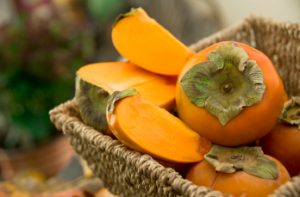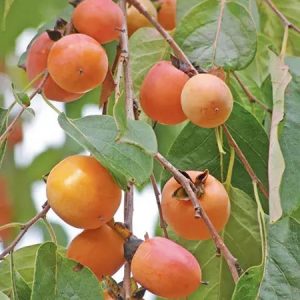We’ve got a persimmon problem in Sonoma County.
Come fall, it seems like any gathering you attend, any street corner you pass holds a huge basket of golden orange persimmons with a sign saying ‘Eat Me!’. So many people I know have moved onto properties with huge persimmon trees that just burst with beautiful fruit in the fall – too much fruit for most families. As many people as there are out there that love persimmons, there is an equal number that just don’t understand them. When do you eat them? How do you cook them? What are the different varieties out there and how do I know which one I have?
I’m here so shed some light on this gorgeous fruit.

Origins
The persimmon was brought to California in the mid 1800’s, originating in China where there are over two thousand different varieties. Here in California, there are two main varieties that you’ll find around your town.
The first one is the Hachiya. You’ll know the Hachiya by its long, oblong shape. And if you’ve ever eaten it too early, you’ll know it as the particularly astringent variety that makes you mouth pucker by just looking at it. To eat the Hachiya fresh, you have to wait until it’s a big sloppy soft mess.
The other main variety around here is the Fuyu. You’ll know the Fuyu as the small apple-shaped variety that grows on huge prolific trees. This one is my favorite since you can eat it right off the tree. Wait till it’s a little soft and squeezable, almost like a pear. I could eat about ten of these a day, and usually do in the fall.
Nutritional Value
One persimmon contains about 55% of your daily needs for vitamin A – promoting healthy immune support, inflammation fighting, eye health and skin health, and control of malignant cells in the body (with studies that link vitamin A intake to the possible prevention of cancer). Additionally, persimmons are loaded with vitamin C, flavanoids, phytonutrients, antioxidants, beta-carotene, lycopene, lutein, and manganese which is said to protect against mouth and lung cancers.

Growing Persimmon Trees
Persimmons thrive in our microclimate that boasts mild summers and moderate winters. Unlike many fruit trees, persimmon trees have a very low chilling requirement in order to produce good flowers and fruit. That means that even in especially warm winters, they’ll perform just fine.
As we’ve seen, persimmon trees can get huge – often reaching 25 feet tall. They are pretty sturdy but do have fairly brittle branches that are prone to damage in high winds. You’ll see flowers emerge on the end of branches by about March. They can be prone to alternate bearing, the habit of producing a heavy fruit set one year and a less than ideal fruit set the following year. To combat this and try to even it out, you can ‘thin’ the fruit (go through and pick off about every other persimmon when they’re only grape-size), and/or prune the tree lightly after a season with low fruit yields.
If you’re just now looking to plant a persimmon tree, choose a spot in either full sun or partial shade (especially if you’re in a hotter area) and make sure to dig a really deep hole as the tree will be growing a super long taproot. Persimmon trees will thrive in a soil pH of 6.5 – 7.5, but will do ok slightly out of that range as well.
Persimmon trees don’t need much in the way of supplemental fertilizer or even water (after they get established), but they will produce higher quality fruit if watered once in a while. Many people never prune their old persimmon trees, but it’s a good idea to limit the tree’s growth and prohibit too much branch breakage from heavy fruit. When you plant the tree, cut back about half of its height, and continue each year by removing some branches entirely. Here’s a great article on how to prune persimmon trees.
How To Eat Persimmons
One thing to consider with astringent varieties like the Hachiya is that while they’ll ripen on the tree, the birds will also be watching and waiting and just might beat you to it. If you pick them while almost ripe and just throw them in a bowl on the counter, they’ll ripen up ok. The best thing to do with astringent types is to harvest them and throw them in the fridge or freezer for a month or more – they’ll be great for eating fresh afterwards.
So get out there and take a closer look at your persimmon tree or the one creeping over from your neighbor’s fence! Here are some great recipes from Williams-Sonoma, though my favorite thing to do with persimmons (besides eating right of the tree) is to freeze, then blend up with a little cream for a frozen treat.







 Family
Family

